The Great Mars Opposition of 2003
As you've no doubt been bombarded with, Mars was closer to the earth on Aug
27, 2003 than at any other time for the past 59,000 years. Why so long? Mars'
orbit is very elliptical, and it reached it's closest point to the sun a mere
48 hours after it reached opposition with the earth. This would be sufficient
for Mars to be at it's closest in a few hundred years, but why 59,000? Because
Jupiter - by far the most massive planet in the solar system - has been tugging
on Mars' orbit and slowly making it more elliptical as the millenia tick by.
Thus, the closest point of Mars orbit to earth's orbit has been getting smaller
and smaller. It will be another 300 or so years before Mars makes a closer approach.
There are more Mars pictures from this and later oppositions on the individual
pages of Chris Kitting and Shahram.
Our Astro 9 students got excited by this prospect, and last year I received
funding for a digital camcorder for doing a new, advanced form of astrophotography:
a couple of years ago it was realized that for planets, it is possible to take
hundreds or thousands of frames in a short time by using a camcorder mated afocally
to a telescope eyepiece. Software was developed for then combing through these
images to find the few that occurred when the atmosphere was momentarily steady
and the image was sharp and clear. By then stacking the best few percent of
all these frames, one could raise the signal-to-noise ratio of the resulting
image by factors upwards of 100. Further processing using software originally
conceived and developed for dealing with the Hubble Space Telescope early images
can then sharpen and enhance the detail uncovered. The final images are beautiful
and impressive, especially if they are taken in fine optics under excellent
"seeing" condition. Alas, we rarely get such great conditions here,
but our crew made field trips to Chews Ridge - measured to be one of the best
astronomical sites in California - and to the high ridges of the Santa Cruz
Mountains in order to take some great photographs of Mars. Here are the first
results from our advanced Astrophotography students (Astro 9B and 9C'rs Jay
Friedland, Allen Ginzburg and Chris Angelos). Expect further tweaking as we
climb the learning curves...
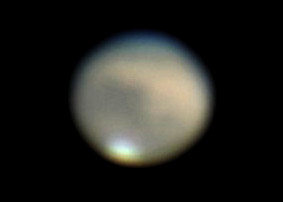 Jay
Friedland made this nice image of Mars on Aug 26, 2003 from C.T. English School
in the Santa Cruz Mountains using our 10" LX200 and 54 seconds of footage
from the camcorder. He used Registax 2 in 'automatic' mode, importing from a
Mac using iMovie, then Quicktime 6.3 Pro to convert to an .avi file. After Registax
found and stacked the best images, he imported the result to Photoshop 7 for
a bit of final sprucing up. Mars was only 15 degrees above the horizon at this
time and the seeing was quite poor, so this posed a challenge. Still, the south
polar cap as well as the CO2 haze over the north pole are clear, as is a number
of basaltic basin markings.
Jay
Friedland made this nice image of Mars on Aug 26, 2003 from C.T. English School
in the Santa Cruz Mountains using our 10" LX200 and 54 seconds of footage
from the camcorder. He used Registax 2 in 'automatic' mode, importing from a
Mac using iMovie, then Quicktime 6.3 Pro to convert to an .avi file. After Registax
found and stacked the best images, he imported the result to Photoshop 7 for
a bit of final sprucing up. Mars was only 15 degrees above the horizon at this
time and the seeing was quite poor, so this posed a challenge. Still, the south
polar cap as well as the CO2 haze over the north pole are clear, as is a number
of basaltic basin markings.
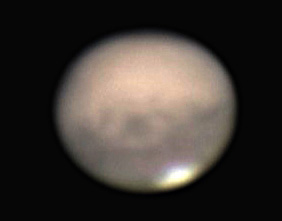 Jay
made this beautiful image later on the night of closest approach, after he,
Allen, Karl and I drove to Lick Observatory and was able to hand-hold his camcorder
to an Astrophysics 7" refractor (at 1:13:48am). A single second of fine
seeing gave 27 frames extracted with iMovie on his Mac and used a DV/DVpro codec
at 29.97 fps to write an .avi file for Registax 2 to stack. Overall level and
contrast, and an unsharp mask were applied in Photoshop. The spooky "Eye
on Mars" is dead center. Nice work!
Jay
made this beautiful image later on the night of closest approach, after he,
Allen, Karl and I drove to Lick Observatory and was able to hand-hold his camcorder
to an Astrophysics 7" refractor (at 1:13:48am). A single second of fine
seeing gave 27 frames extracted with iMovie on his Mac and used a DV/DVpro codec
at 29.97 fps to write an .avi file for Registax 2 to stack. Overall level and
contrast, and an unsharp mask were applied in Photoshop. The spooky "Eye
on Mars" is dead center. Nice work!
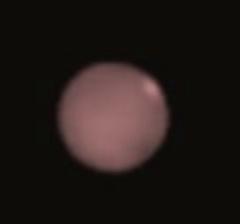 Allen
Ginzburg made this image from his new Intel webcam, which uses prime focus imaging
instead of the afocal imaging used with camcorders. Much cheaper, but requires
long focal length optical input, which was not ideal here. This image is a first
cut, made from a stack of the 67 best, hand-picked frames from a total of 299,
taken from his front yard in Aptos - not a great location for good seeing, alas.
Allen
Ginzburg made this image from his new Intel webcam, which uses prime focus imaging
instead of the afocal imaging used with camcorders. Much cheaper, but requires
long focal length optical input, which was not ideal here. This image is a first
cut, made from a stack of the 67 best, hand-picked frames from a total of 299,
taken from his front yard in Aptos - not a great location for good seeing, alas.
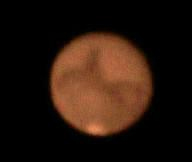 Allen
then got a new Philips Toucam webcam and tried it out with the10" LX200
in Aptos Sept 9, during a night of "terrible seeing, with clouds coming
through constantly", and yet got a strikingly good image. Allen comments
that even the raw video footage looked much better than the footage from his
Intel webcam used to make the picture immediately above. Why? We're intrigued...
possible explanation - the lack of intermediate lenses between the telescope
and the imaging chip. We're in the process of doing a controlled test using
footage from 2 different scopes using the Toucam and the department's Canon
ZR45mc camcorder on the same night, same location.
Allen
then got a new Philips Toucam webcam and tried it out with the10" LX200
in Aptos Sept 9, during a night of "terrible seeing, with clouds coming
through constantly", and yet got a strikingly good image. Allen comments
that even the raw video footage looked much better than the footage from his
Intel webcam used to make the picture immediately above. Why? We're intrigued...
possible explanation - the lack of intermediate lenses between the telescope
and the imaging chip. We're in the process of doing a controlled test using
footage from 2 different scopes using the Toucam and the department's Canon
ZR45mc camcorder on the same night, same location.
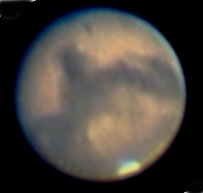 On
Sept 11 Jay, Allen and I accepted an invitation from the Peninsula Astronomical
Society for a night of Mars photography from their Oak Ridge Observatory. Allen
made this incredibly detailed image from the best 82 frames of Toucam webcam
footage taken on the PAS's 16" telescope, processes in Registax. Post processing
included wavelet sharpening and color. The resolution reaches 1 arcsecond in
this image. Syrtis Major is at center, Helles is above the shrinking south polar
cap. Another version of Allen's photograph will be published in an upcoming
issue of "Popular Astronomy"
magazine.
On
Sept 11 Jay, Allen and I accepted an invitation from the Peninsula Astronomical
Society for a night of Mars photography from their Oak Ridge Observatory. Allen
made this incredibly detailed image from the best 82 frames of Toucam webcam
footage taken on the PAS's 16" telescope, processes in Registax. Post processing
included wavelet sharpening and color. The resolution reaches 1 arcsecond in
this image. Syrtis Major is at center, Helles is above the shrinking south polar
cap. Another version of Allen's photograph will be published in an upcoming
issue of "Popular Astronomy"
magazine.
Back to Home
 Jay
Friedland made this nice image of Mars on Aug 26, 2003 from C.T. English School
in the Santa Cruz Mountains using our 10" LX200 and 54 seconds of footage
from the camcorder. He used Registax 2 in 'automatic' mode, importing from a
Mac using iMovie, then Quicktime 6.3 Pro to convert to an .avi file. After Registax
found and stacked the best images, he imported the result to Photoshop 7 for
a bit of final sprucing up. Mars was only 15 degrees above the horizon at this
time and the seeing was quite poor, so this posed a challenge. Still, the south
polar cap as well as the CO2 haze over the north pole are clear, as is a number
of basaltic basin markings.
Jay
Friedland made this nice image of Mars on Aug 26, 2003 from C.T. English School
in the Santa Cruz Mountains using our 10" LX200 and 54 seconds of footage
from the camcorder. He used Registax 2 in 'automatic' mode, importing from a
Mac using iMovie, then Quicktime 6.3 Pro to convert to an .avi file. After Registax
found and stacked the best images, he imported the result to Photoshop 7 for
a bit of final sprucing up. Mars was only 15 degrees above the horizon at this
time and the seeing was quite poor, so this posed a challenge. Still, the south
polar cap as well as the CO2 haze over the north pole are clear, as is a number
of basaltic basin markings. Jay
made this beautiful image later on the night of closest approach, after he,
Allen, Karl and I drove to Lick Observatory and was able to hand-hold his camcorder
to an Astrophysics 7" refractor (at 1:13:48am). A single second of fine
seeing gave 27 frames extracted with iMovie on his Mac and used a DV/DVpro codec
at 29.97 fps to write an .avi file for Registax 2 to stack. Overall level and
contrast, and an unsharp mask were applied in Photoshop. The spooky "Eye
on Mars" is dead center. Nice work!
Jay
made this beautiful image later on the night of closest approach, after he,
Allen, Karl and I drove to Lick Observatory and was able to hand-hold his camcorder
to an Astrophysics 7" refractor (at 1:13:48am). A single second of fine
seeing gave 27 frames extracted with iMovie on his Mac and used a DV/DVpro codec
at 29.97 fps to write an .avi file for Registax 2 to stack. Overall level and
contrast, and an unsharp mask were applied in Photoshop. The spooky "Eye
on Mars" is dead center. Nice work! Allen
Ginzburg made this image from his new Intel webcam, which uses prime focus imaging
instead of the afocal imaging used with camcorders. Much cheaper, but requires
long focal length optical input, which was not ideal here. This image is a first
cut, made from a stack of the 67 best, hand-picked frames from a total of 299,
taken from his front yard in Aptos - not a great location for good seeing, alas.
Allen
Ginzburg made this image from his new Intel webcam, which uses prime focus imaging
instead of the afocal imaging used with camcorders. Much cheaper, but requires
long focal length optical input, which was not ideal here. This image is a first
cut, made from a stack of the 67 best, hand-picked frames from a total of 299,
taken from his front yard in Aptos - not a great location for good seeing, alas. Allen
then got a new Philips Toucam webcam and tried it out with the10" LX200
in Aptos Sept 9, during a night of "terrible seeing, with clouds coming
through constantly", and yet got a strikingly good image. Allen comments
that even the raw video footage looked much better than the footage from his
Intel webcam used to make the picture immediately above. Why? We're intrigued...
possible explanation - the lack of intermediate lenses between the telescope
and the imaging chip. We're in the process of doing a controlled test using
footage from 2 different scopes using the Toucam and the department's Canon
ZR45mc camcorder on the same night, same location.
Allen
then got a new Philips Toucam webcam and tried it out with the10" LX200
in Aptos Sept 9, during a night of "terrible seeing, with clouds coming
through constantly", and yet got a strikingly good image. Allen comments
that even the raw video footage looked much better than the footage from his
Intel webcam used to make the picture immediately above. Why? We're intrigued...
possible explanation - the lack of intermediate lenses between the telescope
and the imaging chip. We're in the process of doing a controlled test using
footage from 2 different scopes using the Toucam and the department's Canon
ZR45mc camcorder on the same night, same location. On
Sept 11 Jay, Allen and I accepted an invitation from the Peninsula Astronomical
Society for a night of Mars photography from their Oak Ridge Observatory. Allen
made this incredibly detailed image from the best 82 frames of Toucam webcam
footage taken on the PAS's 16" telescope, processes in Registax. Post processing
included wavelet sharpening and color. The resolution reaches 1 arcsecond in
this image. Syrtis Major is at center, Helles is above the shrinking south polar
cap. Another version of Allen's photograph will be published in an upcoming
issue of
On
Sept 11 Jay, Allen and I accepted an invitation from the Peninsula Astronomical
Society for a night of Mars photography from their Oak Ridge Observatory. Allen
made this incredibly detailed image from the best 82 frames of Toucam webcam
footage taken on the PAS's 16" telescope, processes in Registax. Post processing
included wavelet sharpening and color. The resolution reaches 1 arcsecond in
this image. Syrtis Major is at center, Helles is above the shrinking south polar
cap. Another version of Allen's photograph will be published in an upcoming
issue of